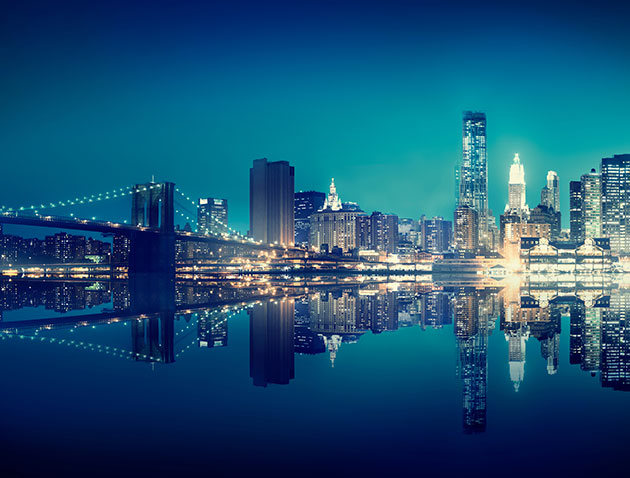It all changed in a New York minute.
At a pace familiar to those in the Big City, New York jumped head-first into the self-driving revolution, offering up its roads for driverless vehicle testing while opening Upstate New York to ridesharing apps like Uber and Lyft.
And while the Empire State has shied away from change, the sudden embrace of the burgeoning technology has some residents—and many taxi and truck drivers—nervous that the state is doing too much too quickly to bring self-driving cars to the East Coast mecca.
Ten-and-Two Gets Eighty-Sixed
New York welcomed self-driving technology in an unconventional way. The program rolled out with the state’s 2017 fiscal budget, which was approved earlier this month.
While heavy hitters like Google, Toyota, and Volkswagen lobbied the state for years to loosen up its vehicle testing standards, a decades-old law requiring all New York drivers to keep at least one hand on the wheel had long disrupted any real chances for the technology to be developed within its borders.
A decades-old law requiring all New York drivers to keep one hand on the wheel disrupted any real chances for the technology to be developed within its borders.
That all changed with New York’s newest fiscal budget, which quietly allowed autonomous vehicles in the testing phase to leapfrog that requirement, even as it introduced a raft of other new regulations that self-driving models must adhere to if being tested in the state.
The measure calls for all driverless car testing to be conducted under the guidance of the New York State Police. The NY Department of Motor Vehicles (DMV) will have to approve any companies wishing to experiment in the Empire State, and the agency will also be tasked with monitoring the autonomous vehicles’ impact on road safety, traffic, and emergency services throughout the test period.
In the past, lawmakers and residents alike met similar measures with misgivings, worried that New York’s compilation of one-way streets and outsize number of cyclists and pedestrians could complicate routes for self-driving cars and lead to even more congestion in an already traffic-logged city.
Others argued that the autonomous technology could eventually lead to the creation of so-called “ghost cars,” vehicles that continuously roam the streets, without stopping, in order to avoid the frustrating task of tracking down a parking spot. While that perpetual motion could benefit those looking to hopscotch around town, it presents bigger issues for the city itself, which could stand to lose hundreds of millions from potential parking tickets. In 2015 alone, New York City raked in $565 million in parking fines.
Still, due to its unusual origin, the trial is only set to last a limited time—for now. Officially, the test phase will last throughout the duration of the budgetary year, due to wrap up next April, with state police slated to issue a final report on the experiment by June 2018.
Meanwhile, Back at the Farm
While self-driving experiments roll out across New York, residents Upstate will see even more change come their way with the introduction of rideshare services to the area—another new addition ushered in by the latest fiscal budget.
The region is one of the last in the United States to have resisted the creep of rideshare apps, although a concession in the plan would allow four of the area’s biggest counties—Buffalo, Syracuse, Yonkers, and Rochester—to abstain from using the technology.
At issue for the region is the disjointed treatment of rideshare and taxi companies, with the latter beholden to many more rules and much tighter regulations. (Rideshare companies in New York City must operate under the city’s taxi structure.)
Specifically, the Upstate municipalities are worried about the amount of insurance—or lack thereof—the rideshare companies will be obligated to pay. It may sound like a petty point, but the price could have a big impact on how much the rideshare companies could charge for their drives, compared to taxi drivers, who have much less wiggle room when it comes to setting fares.
In 2016, rideshare companies including Uber and Lyft spent a combined $2.7 million on lobbying in New York.
For their part, Uber has promised that the move would bring at least 13,000 jobs to Upstate New York. However, the company has also been aggressively expanding its driver-free vehicle experiments for some time; CEO Travis Kalanick hinted in the past that getting rid of drivers all together would be a boon for profits, saying that rides could be made even cheaper if one could get rid of “the dude” driving the car.
The company was also behind a spectacular push for the expansion of rideshare apps into Upstate New York. In conjunction with competitor Lyft, Uber has spent more than $700,000 on lobbying and advertisements in New York this year alone, according to reports compiled by the New York Democrat and Chronicle. In 2016, the companies spent a combined $2.7 million on swaying the state, the report goes on.
It seems, for now, that the persuasive tactics have worked in favor of the tech giants, but New Yorkers are nothing if not tough—and blunt. If they don’t like autonomous cars on their streets or rideshare apps on their phones, they likely won’t have a problem telling Uber and Lyft to “fuggetabout” sticking around.
